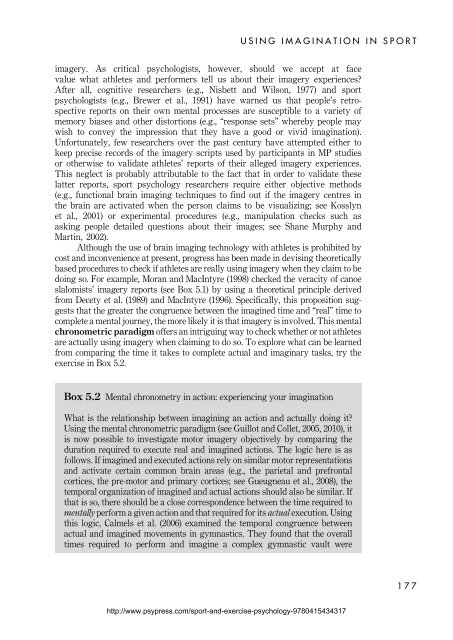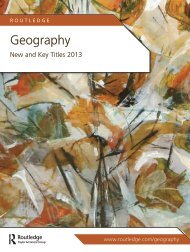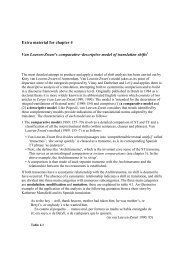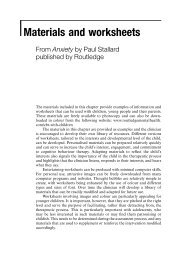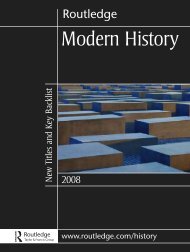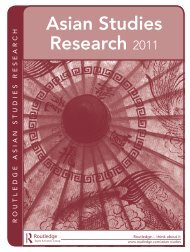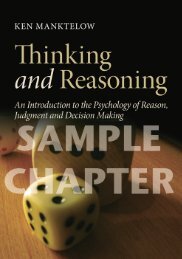Sport and Exercise Psychology: A Critical introduction ... - Routledge
Sport and Exercise Psychology: A Critical introduction ... - Routledge
Sport and Exercise Psychology: A Critical introduction ... - Routledge
Create successful ePaper yourself
Turn your PDF publications into a flip-book with our unique Google optimized e-Paper software.
USING IMAGINATION IN SPORT<br />
imagery. As critical psychologists, however, should we accept at face<br />
value what athletes <strong>and</strong> performers tell us about their imagery experiences?<br />
After all, cognitive researchers (e.g., Nisbett <strong>and</strong> Wilson, 1977) <strong>and</strong> sport<br />
psychologists (e.g., Brewer et al., 1991) have warned us that people’s retrospective<br />
reports on their own mental processes are susceptible to a variety of<br />
memory biases <strong>and</strong> other distortions (e.g., “response sets” whereby people may<br />
wish to convey the impression that they have a good or vivid imagination).<br />
Unfortunately, few researchers over the past century have attempted either to<br />
keep precise records of the imagery scripts used by participants in MP studies<br />
or otherwise to validate athletes’ reports of their alleged imagery experiences.<br />
This neglect is probably attributable to the fact that in order to validate these<br />
latter reports, sport psychology researchers require either objective methods<br />
(e.g., functional brain imaging techniques to find out if the imagery centres in<br />
the brain are activated when the person claims to be visualizing; see Kosslyn<br />
et al., 2001) or experimental procedures (e.g., manipulation checks such as<br />
asking people detailed questions about their images; see Shane Murphy <strong>and</strong><br />
Martin, 2002).<br />
Although the use of brain imaging technology with athletes is prohibited by<br />
cost <strong>and</strong> inconvenience at present, progress has been made in devising theoretically<br />
based procedures to check if athletes are really using imagery when they claim to be<br />
doing so. For example, Moran <strong>and</strong> MacIntyre (1998) checked the veracity of canoe<br />
slalomists’ imagery reports (see Box 5.1) by using a theoretical principle derived<br />
from Decety et al. (1989) <strong>and</strong> MacIntyre (1996). Specifically, this proposition suggests<br />
that the greater the congruence between the imagined time <strong>and</strong> “real” time to<br />
complete a mental journey, the more likely it is that imagery is involved. This mental<br />
chronometric paradigm offers an intriguing way to check whether or not athletes<br />
are actually using imagery when claiming to do so. To explore what can be learned<br />
from comparing the time it takes to complete actual <strong>and</strong> imaginary tasks, try the<br />
exercise in Box 5.2.<br />
Box 5.2 Mental chronometry in action: experiencing your imagination<br />
What is the relationship between imagining an action <strong>and</strong> actually doing it?<br />
Using the mental chronometric paradigm (see Guillot <strong>and</strong> Collet, 2005, 2010), it<br />
is now possible to investigate motor imagery objectively by comparing the<br />
duration required to execute real <strong>and</strong> imagined actions. The logic here is as<br />
follows. If imagined <strong>and</strong> executed actions rely on similar motor representations<br />
<strong>and</strong> activate certain common brain areas (e.g., the parietal <strong>and</strong> prefrontal<br />
cortices, the pre-motor <strong>and</strong> primary cortices; see Gueugneau et al., 2008), the<br />
temporal organization of imagined <strong>and</strong> actual actions should also be similar. If<br />
that is so, there should be a close correspondence between the time required to<br />
mentally perform a given action <strong>and</strong> that required for its actual execution. Using<br />
this logic, Calmels et al. (2006) examined the temporal congruence between<br />
actual <strong>and</strong> imagined movements in gymnastics. They found that the overall<br />
times required to perform <strong>and</strong> imagine a complex gymnastic vault were<br />
http://www.psypress.com/sport-<strong>and</strong>-exercise-psychology-9780415434317<br />
177


